 |
 |
 |
 |
     |
 |
Safety
Aspects
This section
outlines the OSHA standards that affect Incident Command
System workers. This section also offers additional guidance
information applicable to emergency response safety and
health. |
|
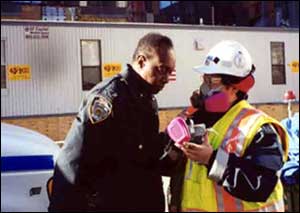 |
| OSHA
Standards Related to the ICS |
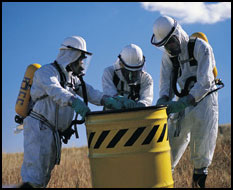 Hazardous Waste Operations and Emergency Response 29
CFR [1910.120]
Hazardous Waste Operations and Emergency Response 29
CFR [1910.120]
Paragraph Q relates directly to Emergency Response.
It says:
- The senior emergency response official responding
to an emergency shall become the individual in charge
of a site-specific Incident Command System (ICS).
All emergency responders and their communications
shall be coordinated and controlled through the individual
in charge of the ICS assisted by the senior official
present for each employer. [1910.120(q)(3)(i)]
NOTE TO PARAGRAPH (q)(3)(i). - The "senior official"
at an emergency response is the most senior official
on the site who has the responsibility for controlling
the operations at the site. Initially it is the
senior officer on the first-due piece of responding
emergency apparatus to arrive on the incident scene.
As more senior officers arrive (i.e., battalion
chief, fire chief, state law enforcement official,
site coordinator, etc.) the position is passed up
the line of authority which has been previously
established.
- The individual in charge of the ICS shall identify,
to the extent possible, all hazardous substances or
conditions present and shall address as appropriate
site analysis, use of engineering controls, maximum
exposure limits, hazardous substance handling procedures,
and use of any new technologies. [1910.120(q)(3)(ii)]
-
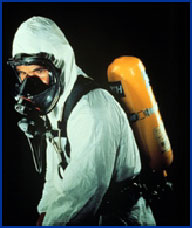 Based on the hazardous substances and/or conditions
present, the individual in charge of the ICS shall
implement appropriate emergency operations, and assure
that the personal protective equipment worn is appropriate
for the hazards to be encountered. However, personal
protective equipment shall meet, at a minimum, the
criteria contained in [29
CFR 1910.156(e)] when worn while performing fire
fighting operations beyond the incipient stage for
any incident. [1910.120(q)(3)(iii)]
Based on the hazardous substances and/or conditions
present, the individual in charge of the ICS shall
implement appropriate emergency operations, and assure
that the personal protective equipment worn is appropriate
for the hazards to be encountered. However, personal
protective equipment shall meet, at a minimum, the
criteria contained in [29
CFR 1910.156(e)] when worn while performing fire
fighting operations beyond the incipient stage for
any incident. [1910.120(q)(3)(iii)]
- Employees engaged in emergency response and exposed
to hazardous substances presenting an inhalation hazard
or potential inhalation hazard shall wear positive
pressure self-contained breathing apparatus while
engaged in emergency response, until such time that
the individual in charge of the ICS determines through
the use of air monitoring that a decreased level of
respiratory protection will not result in hazardous
exposures to employees. [1910.120(q)(3)(iv)]
- The individual in charge of the ICS shall limit
the number of emergency response personnel at the
emergency site, in those areas of potential or actual
exposure to incident or site hazards, to those who
are actively performing emergency operations. However,
operations in hazardous areas shall be performed using
the buddy system in groups of two or more. [1910.120(q)(3)(v)]
-
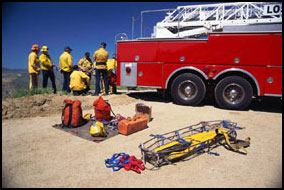 Back-up personnel shall be standing by with equipment
ready to provide assistance or rescue. Qualified basic
life support personnel, as a minimum, shall also be
standing by with medical equipment and transportation
capability. [1910.120(q)(3)(vi)]
Back-up personnel shall be standing by with equipment
ready to provide assistance or rescue. Qualified basic
life support personnel, as a minimum, shall also be
standing by with medical equipment and transportation
capability. [1910.120(q)(3)(vi)]
- The individual in charge of the ICS shall designate
a safety officer, who is knowledgeable in the operations
being implemented at the emergency response site,
with specific responsibility to identify and evaluate
hazards and to provide direction with respect to the
safety of operations for the emergency at hand. [1910.120(q)(3)(vii)]
- When activities are judged by the safety officer
to be an IDLH and/or to involve an imminent danger
condition, the safety officer shall have the authority
to alter, suspend, or terminate those activities.
The safety official shall immediately inform the individual
in charge of the ICS of any actions needed to be taken
to correct these hazards at the emergency scene. [1910.120(q)(3)(viii)]
- After emergency operations have terminated, the
individual in charge of the ICS shall implement appropriate
decontamination procedures. [1910.120(q)(3)(ix)]
- Hazardous materials technicians must be able to
function within an assigned role in the Incident Command
System. [1910.120(q)(6)(iii)(C)]
- On scene incident commander. Incident commanders,
who will assume control of the incident scene beyond
the first responder awareness level, shall receive
at least 24 hours of training equal to the first responder
operations level and in addition have competency in
the following areas and the employer shall so certify:
[1910.120(q)(6)(v)]
- Know and be able to implement the employer's incident
command system. [1910.120(q)(6)(v)(A)]
- Know how to implement the employer's emergency
response plan. [1910.120(q)(6)(v)(B)]
- Know and understand the hazards and risks associated
with employees working in chemical protective clothing.
[1910.120(q)(6)(v)(C)]
- Know how to implement the local emergency response
plan. [1910.120(q)(6)(v)(D)]
- Know of the state emergency response plan and of
the Federal Regional Response Team. [1910.120(q)(6)(v)(E)]
- Know and understand the importance of decontamination
procedures. [1910.120(q)(6)(v)(F)]
|
| Personal
Protective Equipment (PPE) |
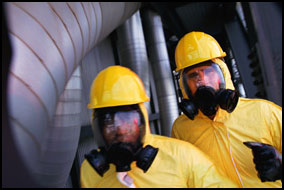 |
If PPE is to
be used to reduce the exposure of ICS/UC workers
to hazards, a PPE program should be initialized
and maintained. This program should contain identification
and evaluation of hazards in the scene and if use
of PPE is an appropriate control measure; if PPE
is to be used, how it is selected, maintained and
its use evaluated; training of workers using the
PPE; and vigilance of the program to determine its
effectiveness in preventing worker injury or illness.
For more on PPE, see
OSHA's Safety and Health topics page on Personal
Protective Equipment. There is a
separate
page for compliance-related material.
|
Additional resources:
- Personal Protective Equipment. OSHA Fact Sheet (2002),
293 KB PDF, 2 pages. Answers to common PPE questions.
- Personal Protective Equipment. OSHA
Publication 3151 (Revised 2004), 46 pages. Also available as a 629 KB
PDF. This publication discusses the types of equipment most commonly
used to protect the head, torso, arms, hands, and feet. Additional topics
include requirements, hazard assessment, selection, and employee training.
- Chemical
Protective Clothing. OSHA Technical Manual, Section
VIII, Chapter 1, 27 pages. These guidelines describe
the various types of clothing that are appropriate
for use in various chemical operations and provide
recommendations in their selection and use.
- A Guide for Evaluating the Performance of Chemical Protective
Clothing. U.S. Department of Human Health Services (DHHS) National Institutes of Safety and Health (NIOSH), Publication No. 90-109
(1990, June), 1.6 MB PDF, 96 pages. This guide includes
selection and evaluation guidelines for protective
clothing.
- Recommendations
for Chemical Protective Clothing. NIOSH (1999,
April 12), 3 pages. A Companion to the NIOSH Pocket
Guide to Chemical Hazards; provides chemical protective
clothing guidelines for chemicals listed in the Pocket
Guide.
- The
National Personal Protective Technology Laboratory
(NPPTL). NIOSH. The NPPTL focuses expertise from
many scientific disciplines to advance federal research
on respirators and other personal protective technologies
for workers. Also features links to PPE-related topics.
|
| Evacuation
Plans and Procedures |
 |
 |
 |
 |
|
OSHA
has an
eTool on evacuation plans and procedures. It
can assist you in creating an emergency action plan,
assure OSHA compliance, identify potential hazards
and help to find additional information. |
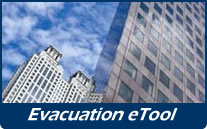 |
 |
 |
 |
 |
 |
 |
 |
|
| ICS/UC
Safety-Related Materials from Other Agencies |

The United States Coast Guard (USCG)
has developed a number of ICS/UC guidance documents and
maintains several ICS/UC-related websites, including:
|
|
|
| | |
|
| | |
Quick links: | | |
| | | | |
|
 |
 |
 |
|

